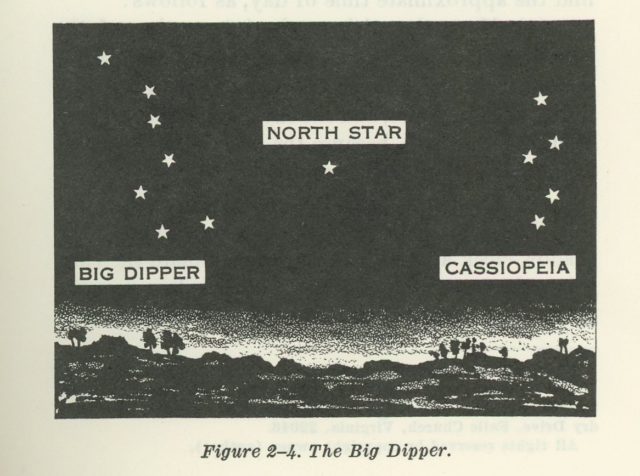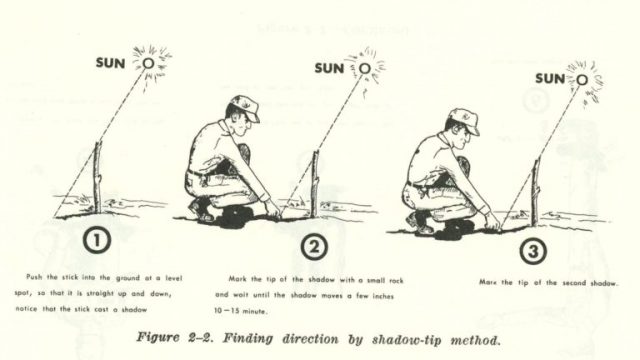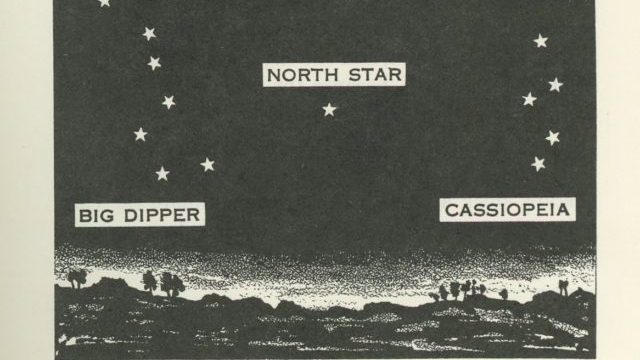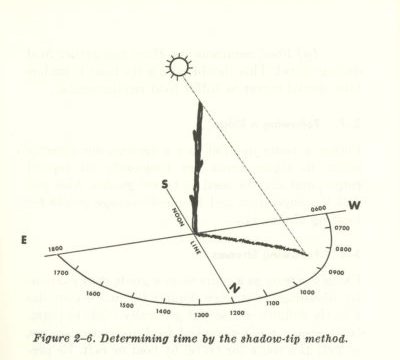Whether you're lost or simply want to be able to tell the time without a watch, these survival tips will help you out. Using the sun and stars can help you in a time of need. Find out how you can use the heavens to guide you home!
1. Finding Direction by Day
via:FM 21-76
(a) Steps to follow. Find a fairly straight stick about 1 meter long and follow these steps:
Step 1: Push the stick into the ground at a fairly level, brush-free spot where a distinct shadow will be cast. The stick need not be vertical; inclining to obtain a more convenient shadow, in size or direction, does not impair the accuracy of the shadow-tip method.
Step 2: Mark the shadow tip with a small peg, stick, stone, twig, your finger, hole in the snow, or other means. Wait until the shadow tip moves a few inches — using a 1 meter stick, 10 to 15 minutes should be sufficient.
Step 3: Mark the new position of the shadow tip.
Step 4: Draw a straight line from the first rock to the second rock and extend it about a foot past the second rock.
Step 5: Stand with the toe of the left foot at the first rock and the toe of the right at the end of the line you drew.
2. Finding Direction at Night
via: FM 21-76
Direction can be determined by means other than a compass:
(1) To find the North Star, look for the Big Dipper. The two stars at the end of the bowl are called the “pointers.” In a straight line out from the “pointers” is the North Star (at about five times the points). The Big Dipper rotates slowly around the North Star and does not always appear in the same position (fig. 2-4). The constellation Cassiopeia can also be used. This group of five bright stars is shaped like a lopsided M (or W, when it is low in the sky). The North Star is straight out from the Big Dipper. Cassiopeia also rotates slowly around the North Star and is always almost directly opposite the Big Dipper. Its position, opposite the Big Dipper, makes it a valuable aid when the Big Dipper is low in the sky, possibly out of sight because of vegetation or high terrain features.
3. Determining Time
via: FM 21-76
(1) Move the stick to the intersection of the east-west line and the north-south line, and set it vertically in the ground. The west part of the line indicates 0600 hours, and the east part is 1800, ANYWHERE on earth, because the basic rule, described in 1c in “Finding Direction by Day” above always applies.
(2) The north-south line now becomes the noon line. The shadow of the stick is an hour hand in the shadow-clock and with it you can estimate the time using the noon line and the 6 o’clock line as your guides (fig. 2-6). Depending on your location and the season, the shadow may move either clockwise or counterclockwise, but this does not alter your manner of reading the shadow-clock.
Once you get the hang of it, this skill is pretty easy to have in your back pocket. When you need it the most, you will be able to find your way home and head in the right direction with the help of the sun and stars.
For more on these tips, be sure to visit Art of Manliness.
Featured Image via: FM 21-76







Reno
Does this still work if youre a flat earther? Haha
Good luck walking at night
Old school
You can use L.U.R.D. at night.
Whatever that is
It’s got me beat how people get lost out there you wud think they know about it people are so dumb arses lol
Shannon Mckinley
Check out AlfieAesthetic on YouTube. Dude is awesome and has a bunch of navigation vids.
Shyla Curtis
interesting, but i think i would prefer to shelter in place at night and move during the day. i have been bad lost once, it wasnt fun. that being said right after i was found and got home i bought a compass and learned to use it. since then i learned the sunrise east sunset west thing. trouble is you have to know which way is actually out.
If you are being hunted it would behoove you to run at night, george. Just a thoyght,brother.BH
Justice Lowry